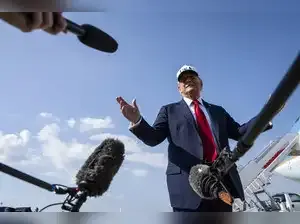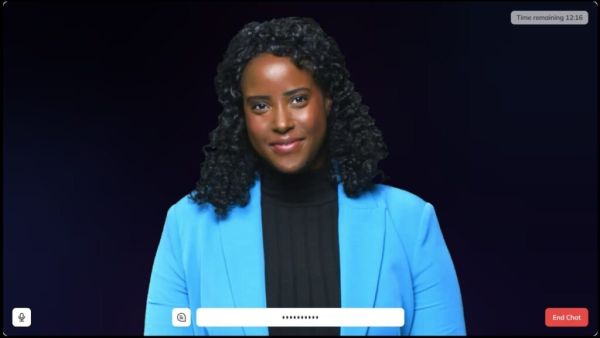Just over a year ago at Mar-a-Lago, David Bailey and a group of top bitcoin executives made a pitch to Donald Trump.
They were looking for a savior.
For years, cryptocurrency companies had endured a cascade of lawsuits, regulatory attacks and prosecutions that threatened the industry's survival.
Trump wasn't an obvious sympathizer. He had once dismissed bitcoin as a "scam." But he welcomed the executives into his private club in Florida because the industry had gotten his attention. Bailey was mobilizing crypto investors to vote for Trump and had called on his colleagues to raise $100 million for the election effort.
At Mar-a-Lago, Bailey brought along representatives of several large bitcoin mining firms -- an energy-guzzling sector that has drawn noise complaints and environmental concerns. They pitched Trump on the economic benefits of bitcoin, before pivoting to a bold request: Could Trump write a supportive post on his social media site?
The proposed language was included at the bottom of a meeting agenda, according to a copy reviewed by The New York Times. Trump said he would "consider it," Bailey, who runs digital currency firm BTC Inc., recalled in an interview. "We had no idea if that was going to happen."
That night, Trump fired off a Truth Social post containing the exact message proposed by the executives: "We want all the remaining Bitcoin to be MADE IN THE USA!!! It will help us be ENERGY DOMINANT!!!"
The post was one of the earliest successes in a high-stakes lobbying campaign by the crypto industry that has put huge sums of money behind Trump and reaped enormous rewards.
Since Trump's election, the price of bitcoin, the most valuable cryptocurrency, has skyrocketed to more than $100,000, enriching executives who supported his campaign. Crypto advocates who were shunned in Washington during the Biden administration now enjoy astonishing access to the Trump White House, which has quickly unwound the regulatory crackdown. And the federal government has embraced pro-crypto policies that could upend the U.S. financial system for decades.
Virtually every step of Trump's transformation has been steered by the industry. Lacking much knowledge of its intricacies, Trump embraced crypto when he saw it could generate huge profits for him or his political groups, while outsourcing the details to industry advisers with their own business ambitions, according to documents and audio recordings, as well as interviews with more than 50 people involved in Trump's crypto plans.
Now he is deeply enmeshed in an industry that his administration regulates. He and his sons unveiled their own crypto business last fall, the start of a blitz of new ventures that has grown to include four Trump-branded digital currencies and even a bitcoin mining company.
Just this spring, crypto investors spent almost $200 million on a digital token called a meme coin marketed by Trump, vying for the chance to bend the president's ear at a dinner. Crypto interests also donated about $18 million to Trump's inaugural committee and millions more to his political groups, while spending over $130 million to support congressional candidates who backed the industry.
Crypto enthusiasts have a term for the conversion of a bitcoin skeptic into a believer. They call it "orange pilling," a reference to bitcoin's signature color and to a plotline from the 1999 movie "The Matrix."
Trump was a prime target.
In the past, he had called crypto "not money" and "based on thin air."
Trump began to soften on crypto after he was approached by a longtime business partner, Bill Zanker.
In the 1980s, Zanker founded a for-profit education company, the Learning Annex, that offered presentations from celebrities, including Trump, on how to succeed in life and business. Zanker later wrote a book with Trump and went on to dabble in a range of other ventures.
By 2022, Zanker had reinvented himself as a crypto entrepreneur, and he pitched Trump on a series of nonfungible tokens -- collectible digital images built on the same technology as crypto, like baseball cards for the internet era. Each image featured a cartoon likeness of Trump. Zanker told him that the NFTs could generate as much as $100 million.
The NFTs went on sale in December 2022, marketed as Trump Digital Trading Cards, and sold out almost immediately. (Trump received more than $7 million from NFT sales, according to a financial disclosure filed last year, which covered 2023 and the first few months of 2024.)
About a year after the initial sale, in November 2023, crypto enthusiasts who had bought the NFTs were invited to Mar-a-Lago to meet Trump. It was a crucial moment in Trump's conversion, one of the first times he championed crypto investments to a crowd of supporters.
Addressing his guests, the former president seemed unsure how to describe the peculiar new financial product he was hawking -- "modern art or whatever," he said, according to a recording obtained by the Times. But he was confident that he had made a lot of money from the images, which went on sale for $99 each.
Under President Joe Biden, the Securities and Exchange Commission had filed lawsuits against an array of major crypto companies, setting up years of court fights. Sen. Elizabeth Warren, D-Mass., had rallied a group of lawmakers who argued that crypto was fundamentally dangerous to the economy. Industry entreaties to Biden's reelection campaign had largely failed.
So in early 2024, a small group of crypto executives embarked on a courtship of Trump.
Among the leaders in that effort was Bailey, who organizes one of the industry's largest corporate conferences. He worked closely with Tracy Hoyos-López, a bitcoin advocate and former prosecutor who had a valuable personal connection: Her father was friends with Paul Manafort, Trump's 2016 campaign chair.
Manafort helped pave the way for an introductory meeting between Bailey and Trump at Trump Tower in New York in May 2024.
Bailey was joined there by three other crypto advocates. They argued that crypto investors could become a significant voting bloc, on par with supporters of the gun industry. And they pointed out that Warren was one of their industry's main antagonists.
At one point, Bailey said, he presented a chart showing how much bitcoin's price had risen during Trump's first term. He called it "the Trump Pump."
Five days later, Trump gave a speech at the Libertarian Party's nominating convention, where he promised to "stop Joe Biden's crusade to crush crypto" and "keep Elizabeth Warren and her goons away from your bitcoin."
Soon millions of dollars in crypto money started flowing into the Trump campaign.
The founders of Kraken and Gemini, crypto exchanges that had been sued by the SEC, each donated more than $1 million to groups backing Trump. In June, venture capital investor David Sacks held a fundraiser for Trump at his home in San Francisco, where the candidate dined with a group of executives, including a top lawyer at Coinbase, the largest U.S. exchange and another SEC target.
Bailey was also rallying support. He arranged for the bitcoin mining executives to visit Mar-a-Lago in June and raised $30 million to support Trump's election effort, he said.
Crucially, he also secured the candidate as the keynote speaker at the annual bitcoin conference in Nashville, Tennessee. The event, organized by Bailey's company, promised to bring together tens of thousands of crypto enthusiasts -- a tantalizing pool of potential supporters.
As the conference approached, Bailey learned that Sen. Cynthia Lummis, R-Wyo., a longtime crypto booster, was planning to introduce a bill calling for the establishment of a national bitcoin reserve, a kind of Fort Knox for the digital age.
Bailey was intrigued. A federal reserve would give a government imprimatur to an industry long snubbed in Washington, elevating bitcoin to the level of strategic assets like gold and petroleum. He asked the Trump campaign to endorse the proposal.
Again, Trump delivered.
In front of thousands of cheering supporters in Nashville, he promised to create a "strategic national bitcoin stockpile."
"I will be the pro-innovation and pro-bitcoin president that America needs," Trump declared.
If the orange-pilling of Trump began as a behind-the-scenes influence campaign, operating on the margins of the presidential race, it became a public spectacle after his victory in November.
Within a month of the election, Trump chose Sacks as his "AI and crypto czar," in charge of managing the administration's technology policy.
But virtually everyone in the crypto world was jockeying for direct access to the White House. Crypto businesses and their executives spent $9.9 million on lobbyists in the first three months of 2025.
On March 6, Trump issued an executive order that established a federal reserve containing bitcoin that the government had already obtained in legal seizures, with a promise to consider acquiring more in the future.
Trump reviewed the documentation in the Oval Office, with Sacks at his side.
"This is something you believe in fully?" the president asked.
"One hundred percent," Sacks replied.
"And I made the promise, right?" Trump asked again.
"Absolutely," Sacks told him.
Trump signed the order.
This article originally appeared in The New York Times.
They were looking for a savior.
For years, cryptocurrency companies had endured a cascade of lawsuits, regulatory attacks and prosecutions that threatened the industry's survival.
Trump wasn't an obvious sympathizer. He had once dismissed bitcoin as a "scam." But he welcomed the executives into his private club in Florida because the industry had gotten his attention. Bailey was mobilizing crypto investors to vote for Trump and had called on his colleagues to raise $100 million for the election effort.
At Mar-a-Lago, Bailey brought along representatives of several large bitcoin mining firms -- an energy-guzzling sector that has drawn noise complaints and environmental concerns. They pitched Trump on the economic benefits of bitcoin, before pivoting to a bold request: Could Trump write a supportive post on his social media site?
The proposed language was included at the bottom of a meeting agenda, according to a copy reviewed by The New York Times. Trump said he would "consider it," Bailey, who runs digital currency firm BTC Inc., recalled in an interview. "We had no idea if that was going to happen."
That night, Trump fired off a Truth Social post containing the exact message proposed by the executives: "We want all the remaining Bitcoin to be MADE IN THE USA!!! It will help us be ENERGY DOMINANT!!!"
The post was one of the earliest successes in a high-stakes lobbying campaign by the crypto industry that has put huge sums of money behind Trump and reaped enormous rewards.
Since Trump's election, the price of bitcoin, the most valuable cryptocurrency, has skyrocketed to more than $100,000, enriching executives who supported his campaign. Crypto advocates who were shunned in Washington during the Biden administration now enjoy astonishing access to the Trump White House, which has quickly unwound the regulatory crackdown. And the federal government has embraced pro-crypto policies that could upend the U.S. financial system for decades.
Virtually every step of Trump's transformation has been steered by the industry. Lacking much knowledge of its intricacies, Trump embraced crypto when he saw it could generate huge profits for him or his political groups, while outsourcing the details to industry advisers with their own business ambitions, according to documents and audio recordings, as well as interviews with more than 50 people involved in Trump's crypto plans.
Now he is deeply enmeshed in an industry that his administration regulates. He and his sons unveiled their own crypto business last fall, the start of a blitz of new ventures that has grown to include four Trump-branded digital currencies and even a bitcoin mining company.
Just this spring, crypto investors spent almost $200 million on a digital token called a meme coin marketed by Trump, vying for the chance to bend the president's ear at a dinner. Crypto interests also donated about $18 million to Trump's inaugural committee and millions more to his political groups, while spending over $130 million to support congressional candidates who backed the industry.
Crypto enthusiasts have a term for the conversion of a bitcoin skeptic into a believer. They call it "orange pilling," a reference to bitcoin's signature color and to a plotline from the 1999 movie "The Matrix."
Trump was a prime target.
In the past, he had called crypto "not money" and "based on thin air."
Trump began to soften on crypto after he was approached by a longtime business partner, Bill Zanker.
In the 1980s, Zanker founded a for-profit education company, the Learning Annex, that offered presentations from celebrities, including Trump, on how to succeed in life and business. Zanker later wrote a book with Trump and went on to dabble in a range of other ventures.
By 2022, Zanker had reinvented himself as a crypto entrepreneur, and he pitched Trump on a series of nonfungible tokens -- collectible digital images built on the same technology as crypto, like baseball cards for the internet era. Each image featured a cartoon likeness of Trump. Zanker told him that the NFTs could generate as much as $100 million.
The NFTs went on sale in December 2022, marketed as Trump Digital Trading Cards, and sold out almost immediately. (Trump received more than $7 million from NFT sales, according to a financial disclosure filed last year, which covered 2023 and the first few months of 2024.)
About a year after the initial sale, in November 2023, crypto enthusiasts who had bought the NFTs were invited to Mar-a-Lago to meet Trump. It was a crucial moment in Trump's conversion, one of the first times he championed crypto investments to a crowd of supporters.
Addressing his guests, the former president seemed unsure how to describe the peculiar new financial product he was hawking -- "modern art or whatever," he said, according to a recording obtained by the Times. But he was confident that he had made a lot of money from the images, which went on sale for $99 each.
Under President Joe Biden, the Securities and Exchange Commission had filed lawsuits against an array of major crypto companies, setting up years of court fights. Sen. Elizabeth Warren, D-Mass., had rallied a group of lawmakers who argued that crypto was fundamentally dangerous to the economy. Industry entreaties to Biden's reelection campaign had largely failed.
So in early 2024, a small group of crypto executives embarked on a courtship of Trump.
Among the leaders in that effort was Bailey, who organizes one of the industry's largest corporate conferences. He worked closely with Tracy Hoyos-López, a bitcoin advocate and former prosecutor who had a valuable personal connection: Her father was friends with Paul Manafort, Trump's 2016 campaign chair.
Manafort helped pave the way for an introductory meeting between Bailey and Trump at Trump Tower in New York in May 2024.
Bailey was joined there by three other crypto advocates. They argued that crypto investors could become a significant voting bloc, on par with supporters of the gun industry. And they pointed out that Warren was one of their industry's main antagonists.
At one point, Bailey said, he presented a chart showing how much bitcoin's price had risen during Trump's first term. He called it "the Trump Pump."
Five days later, Trump gave a speech at the Libertarian Party's nominating convention, where he promised to "stop Joe Biden's crusade to crush crypto" and "keep Elizabeth Warren and her goons away from your bitcoin."
Soon millions of dollars in crypto money started flowing into the Trump campaign.
The founders of Kraken and Gemini, crypto exchanges that had been sued by the SEC, each donated more than $1 million to groups backing Trump. In June, venture capital investor David Sacks held a fundraiser for Trump at his home in San Francisco, where the candidate dined with a group of executives, including a top lawyer at Coinbase, the largest U.S. exchange and another SEC target.
Bailey was also rallying support. He arranged for the bitcoin mining executives to visit Mar-a-Lago in June and raised $30 million to support Trump's election effort, he said.
Crucially, he also secured the candidate as the keynote speaker at the annual bitcoin conference in Nashville, Tennessee. The event, organized by Bailey's company, promised to bring together tens of thousands of crypto enthusiasts -- a tantalizing pool of potential supporters.
As the conference approached, Bailey learned that Sen. Cynthia Lummis, R-Wyo., a longtime crypto booster, was planning to introduce a bill calling for the establishment of a national bitcoin reserve, a kind of Fort Knox for the digital age.
Bailey was intrigued. A federal reserve would give a government imprimatur to an industry long snubbed in Washington, elevating bitcoin to the level of strategic assets like gold and petroleum. He asked the Trump campaign to endorse the proposal.
Again, Trump delivered.
In front of thousands of cheering supporters in Nashville, he promised to create a "strategic national bitcoin stockpile."
"I will be the pro-innovation and pro-bitcoin president that America needs," Trump declared.
If the orange-pilling of Trump began as a behind-the-scenes influence campaign, operating on the margins of the presidential race, it became a public spectacle after his victory in November.
Within a month of the election, Trump chose Sacks as his "AI and crypto czar," in charge of managing the administration's technology policy.
But virtually everyone in the crypto world was jockeying for direct access to the White House. Crypto businesses and their executives spent $9.9 million on lobbyists in the first three months of 2025.
On March 6, Trump issued an executive order that established a federal reserve containing bitcoin that the government had already obtained in legal seizures, with a promise to consider acquiring more in the future.
Trump reviewed the documentation in the Oval Office, with Sacks at his side.
"This is something you believe in fully?" the president asked.
"One hundred percent," Sacks replied.
"And I made the promise, right?" Trump asked again.
"Absolutely," Sacks told him.
Trump signed the order.
This article originally appeared in The New York Times.








